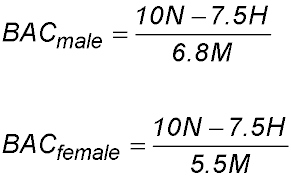Where the techniques of Maths
are explained in simple terms.
Algebra - Blood Alcohol Content.
Main concepts.
- Algebra & Number
- Calculus
- Financial Maths
- Functions & Quadratics
- Geometry
- Measurement
- Networks & Graphs
- Probability & Statistics
- Trigonometry
- Maths & beyond
- Index
See the table at the end of this page for links to questions.
It is important for all people to understand what is implied by Blood Alcohol Content (BAC) and what the implications are. We are often referencing the term or seeing references to it in News broadcasts and on social media.
What is Blood Alcohol Content.
Blood alcohol content (or concentration) is a measure of the amount of ethanol in a sample of blood. The definition of BAC varies across countries.
- some countries use the ratio of the number of grams of alcohol to the volume of blood.
- other countries use the ratio of the number of grams of alcohol to the number of grams of blood.
These differences can be removed by knowing that 1 milliliter of blood has a mass of approximately 1.06 grams. Hence the values recorded are very similar but just a bit different.
Australia, Canada, many European countries, the United Kingdom and the United States measure blood alcohol by volume of blood -
for example mass of alcohol in the blood per 100 ml of blood. So 1 gram of alcohol in 100 ml of blood would be 1%.Scandavian countries, Germany and Russia measure blood alcohol by mass of blood for example mass of alcohol in the blood per 1 gram of blood.
So 1 gram of alcohol in 100 grams of blood is also 1% - meaning 1 centigram of alcohol per 94.3 ml of blood (100 grams divided by 1.06 from above) or 1.06% by volume.
Putting those values into a different perspective, one standard drink contains 10 grams of alcohol. The body can break down the alcohol at the approximate rate of 8.8 grams per hour although this rate varies according to person and circumstances.
For the average person, about three to four drinks in one hour will produce a BAC reading of 0.08. After one hour, that reading will reduce to about 0.065. That rate of reduction will be maintained at approximately 0.015 until the level of about zero (best to interpret the value produced by this calculation as a lower limit and so add an hour or so).
Why use a breathanalyser?
A commonly asked question seeks to determine if the alcohol is in the blood, why test someone's breath.
A breathanalyser machine measures the amount of ethanol in someone's breath. The machine converts that ethanol into acetic acid and an electric current is produced between an anode and a cathode. The more alcohol in the breath, the stronger the current.
Estimating the amount of alcohol in the blood.
In the absence of professional equipment, it is possible to make an estimate of the BAC level for a person based on various factors.
One formula was developed by Widmark (and is discussed by Kenderdie elsewhere). It is very complex and involves 8 variables.
Alternative formulae have been developed which result in similar values but these are based on just three variables - making them easier to use although not as accurate. They are:

where N = the number of standard drinks consumed;
H is the number of hours to consume those drinks; and
M is a person's body mass (in kgs).
Separate equations were developed for males and females because of the differences in the rate of absorbing alcohol between females and males.
To estimate the time to reduce a BAC reading to zero (using the rate above) is

What factors affect the amount of alcohol in the blood?
There are a number of factors which can affect the amount of alcohol in a persons blood.
A good summary of these factors is provided elsewhere. These factors need to be known - for your own sake as well as being asked in many examinations. So be prepared on both counts!! The factors include:
- body size;
- whether you have eaten or not;
- your body fat;
- how fast your body processes alcohol;
- whether you are male or female;
- how often you drink;
- age.
Details of each of these are covered on the website recommended above - produced by experts.
Effects of alcohol.
The effect of alcohol on a person vary according to many factors. These include especially gender, age and percentage body fat. In general, alcohol changes behaviour and can create impairment to reflexes, mental processes and reactions, etc
An excellent review of the effect is given at the start of an ADF article referenced by the following hyperlink. Please check it out!!
Unfortunately many people believe alcohol has no effect on them. It does - such people just cannot see themselves.